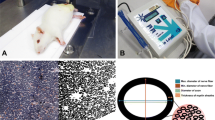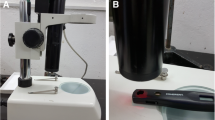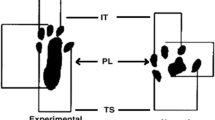Abstract
We evaluated the electrophysiological and histopathological effects of low-energy gallium arsenide (904 nm) laser irradiation on the intact skin injured rat sciatic nerve. Twenty-four male Wistar rats were divided into three groups (n=8 each). At the level of proximal third of the femur the sciatic nerve was crushed bilaterally with an aneursym clip (Aesculap FE 751, Tuttingen, Germany) for half a second. A gallium arsenide laser (wavelength 904 nm, pulse duration 220 ns, peak power per pulse 27 W, spot size 0.28 cm2, pulse repetition rate 16, 128 and 1000 Hz; total applied energy density 0.31, 2.48 and 19 J/cm2) was applied to the right sciatic nerve for 15 min daily at the same time on 7 consecutive days. The same procedure was performed on the left sciatic nerve of same animal, but without radiation emission, and this was accepted as control. Compound muscle action potentials were recorded from right and left sides in all three groups before surgery, just at the end of injury, at the 24th hour and on the 14th and 21st days of injury in all rats using a BIOPAC MP 100 Acquisition System Version 3.5.7 (Santa Barbara, USA). BIOPAC Acknowledge Analysis Software (ACK 100 W) was used to measure CMAP amplitude, area, proximal and distal latency, total duration and conduction velocity. Twenty-one days after injury, the rats were sacrificed. The sciatic nerves of the operated parts were harvested from the right and left sides. Histopathological evaluation was performed by light microscopy. Statistical evaluation was done using analysis of variance for two factors (right and left sides) repeated-measures (CMAP variables within groups) and the Tukey–Kramer Honestly Significant Difference test (CMAP variables between laser groups). The significance was set at p ≤ 0.05. No statistically significant difference (p ≥ 0.05) was found regarding the amplitude, area, duration and conduction velocity of CMAP for each applied dose (0.31, 2.48 and 19 J/cm2) on the irradiated (right) side and the control (left) side, or between irradiated groups. Twenty-one days after injury there were no qualitative differences in the morphological pattern of the regenerated nerve fibres in either irradiated (0.31, 2.48 and 19 J/cm2) or control nerves when evaluated by light microscopy. This study showed that low-energy GaAs irradiation did not have any effect on the injured rat sciatic nerve.
Similar content being viewed by others
Author information
Authors and Affiliations
Corresponding author
Rights and permissions
About this article
Cite this article
Bagis, S., Comelekoglu, U., Coskun, B. et al. No effect of GA-AS (904 nm) laser irradiation on the intact skin of the injured rat sciatic nerve. Lasers Med Sci 18, 83–88 (2003). https://doi.org/10.1007/s10103-003-0258-6
Received:
Accepted:
Issue Date:
DOI: https://doi.org/10.1007/s10103-003-0258-6




